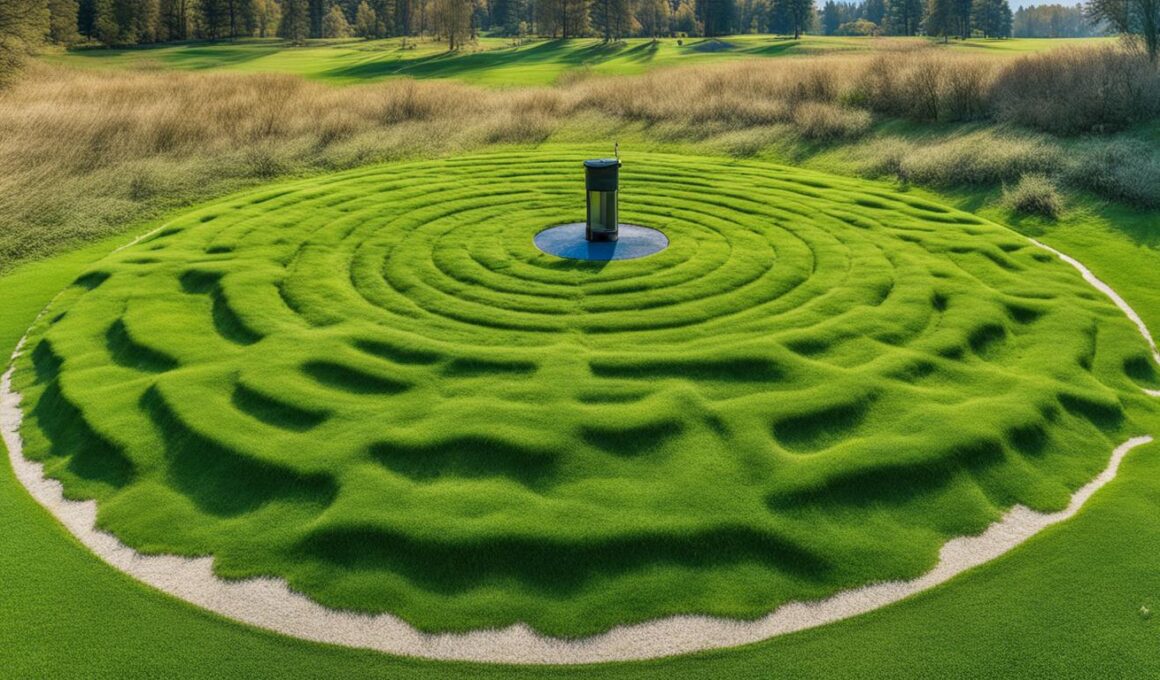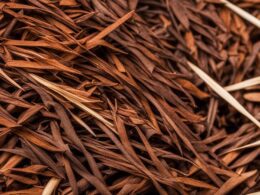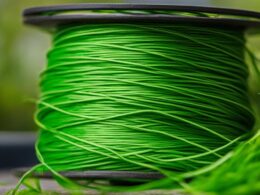Welcome to our comprehensive guide on how to effectively treat and eradicate fairy ring, a common fungal disease that can affect your lawn. If you’ve noticed rings of mushrooms or lush green circular bands of grass in your yard, you may be dealing with this unsightly lawn fungus.
Fairy ring is caused by a fungus called basidiomycetes found in the soil. This fungus feeds on organic matter and releases nutrients, resulting in the appearance of dark green grass in a circular pattern. Mushrooms also grow as a visible sign of the fungus. While fairy ring doesn’t cause major damage to your lawn, its presence can be an aesthetic issue that you’ll want to address.
In this article, we will provide you with effective lawn treatment tips to help you get rid of fairy ring and restore the beauty of your yard. We will cover everything from understanding the symptoms and identification of fairy ring to inspection techniques, treatment options, and preventive measures to minimize the chances of future infestations.
Join us as we dive into the world of fairy ring and equip you with the knowledge and tools you need to combat this lawn fungus. Let’s get started!
Understanding Fairy Ring Symptoms and Identification
Fairy Ring is a lawn disease that presents itself in various symptoms, allowing you to easily identify its presence in your yard. By recognizing these symptoms, you can take appropriate action to control and eradicate Fairy Ring effectively.
One of the most noticeable signs of Fairy Ring is the presence of circular patterns of mushrooms. These mushrooms typically form a ring or an arc shape, often appearing in the outer edge or center of the affected area. The mushrooms can vary in size, color, and texture, but their presence is a clear indication of Fairy Ring.
Another key symptom is the appearance of rings of dead or necrotic grass. These rings can range in size from a few inches to several feet in diameter. The grass within these rings may turn brown, wilt, or die, creating a stark contrast to the healthy vegetation around them.
Conversely, Fairy Ring can also stimulate the growth of grass in the affected area. Circular bands of dark green grass may appear within or around the ring of mushrooms. This lush and vibrant grass is a result of the fungal activity in the soil, which releases nutrients and promotes accelerated growth.
The presence of any of these symptoms – circular patterns of mushrooms, rings of dead grass, or stimulated growth of grass – is a strong indication that your lawn is affected by Fairy Ring. Identifying the disease accurately is crucial before proceeding with any treatment methods, ensuring that you address the issue effectively and prevent its further spread.
Inspection and Where to Look for Fairy Ring
When inspecting for Fairy Ring, it is important to carefully examine your lawn for specific spots and signs. Look for areas with rings, arcs, or patches of grass that exhibit the symptoms mentioned in the previous section. These symptoms may include rings of mushrooms, circular bands of dark green grass, or necrotic patches of vegetation.
Fairy Ring can grow in various spots within a lawn, so pay close attention to all areas, particularly those with short grass or spots lacking turf growth. These grassy areas are often prime locations for Fairy Ring to develop and spread. Additionally, be mindful of areas with high nitrogen levels in the soil, as this can trigger the growth of the Fairy Ring fungus.
Proper inspection is crucial in accurately identifying the presence of Fairy Ring and determining the extent of the infestation in your lawn. By thoroughly examining your grassy areas, focusing on spots with short grass, and considering the impact of high nitrogen levels, you can effectively locate and address the Fairy Ring problem.
Treatment Options for Fairy Ring
The recommended treatment for Fairy Ring is applying fungicides. One effective option is Consan 20, which contains the active ingredient Alkyl dimethyl benzyl ammonium chloride. Consan 20 has proven efficacy in controlling Fairy Ring and is cost-effective.
Proper application of the fungicide is crucial for successful treatment. Begin by identifying the affected areas in your lawn where Fairy Ring is present. Follow the instructions provided with the fungicide for dilution and spraying. Be sure to cover the affected areas thoroughly, as well as the surrounding grass.
Consan 20 should be applied during the active growing season of your grass, typically in spring or early summer. Repeat the treatment as necessary, following the instructions on the product label.
While fungicide application is important for treating Fairy Ring, it is also essential to implement preventive measures to prevent the re-emergence of this lawn fungus.
Note: The image above illustrates a visually appealing and relevant view of a Fairy Ring treatment.
To minimize the likelihood of future Fairy Ring infestations, consider the following preventive measures:
- Maintain proper lawn care practices, including regular mowing, watering, and fertilization.
- Avoid excessive nitrogen fertilization, as high nitrogen levels can promote the growth of Fairy Ring fungus.
- Aerate your lawn to improve water and nutrient absorption and reduce soil compaction.
- Overseed thin or bare areas to promote healthy turf growth and reduce the risk of fungal diseases.
By combining proper treatment with fungicides and implementing preventive measures, you can effectively control Fairy Ring and maintain a healthy, vibrant lawn.
Preventing Future Fairy Ring Infestations
Prevention is the key to controlling Fairy Ring and avoiding future infestations. By incorporating organic practices into your lawn maintenance routine, you can create a healthy environment that discourages the growth of Fairy Ring fungus.
One important aspect of prevention is proper watering. Ensure that you water your lawn deeply and infrequently, rather than shallowly and frequently. This encourages deep root growth and helps the grass develop a strong and resilient system, making it less susceptible to Fairy Ring.
Regular mowing at the correct height is also crucial. Keep your grass at a height of about 2-3 inches to promote dense growth and shade the soil, minimizing the conditions favorable for Fairy Ring development.
Aeration is another beneficial practice that can prevent Fairy Ring. By aerating the soil, you improve water and nutrient penetration, creating a healthy root zone for the grass. This helps maintain a balanced soil structure and reduces the likelihood of Fairy Ring fungus growth.
Fertilization is essential for overall lawn health, but it’s important to use fertilizers with caution. Avoid excessive nitrogen, as it can stimulate the growth of Fairy Ring fungus. Opt for slow-release or organic fertilizers to ensure a steady and controlled release of nutrients.
By following these preventive measures, you can maintain a healthy lawn and minimize the chances of future Fairy Ring infestations. Remember, prevention is the best defense against lawn diseases, so make sure to prioritize organic practices and proper lawn maintenance.
How Fairy Ring Spreads and its Impact on Your Lawn
Fairy Ring, a common lawn disease, spreads through the release of fungal spores that can be carried by wind and water to new areas. These spores then grow into an underground structure called mycelium, forming the characteristic circular shape of the Fairy Ring.
The impact of Fairy Ring on your grass can vary depending on the type of symptoms observed. In Type I symptoms, Fairy Ring can hinder water absorption, leading to wilted or dead grass. On the other hand, Type II symptoms involve the stimulated growth of dark green grass within the ring. Additionally, Type III symptoms manifest as the growth of mushrooms.
It is crucial to have a proper understanding of how Fairy Ring spreads and its impact on the grass to effectively treat and prevent its recurrence. By addressing the issues related to water absorption and grass growth, you can successfully combat Fairy Ring and maintain a healthy, vibrant lawn.
Is the Lawn Treatment for Eradicating Fairy Rings Safe for Bees?
When considering lawn treatment options to get rid of bumble bees, it’s important to prioritize the safety of our pollinator friends. Use organic and bee-friendly solutions to eradicate fairy rings without harming bees. Avoid chemical treatments and opt for environmentally safe methods to protect the bee population while maintaining a healthy lawn.
Conclusion
In summary, Fairy Ring is a common lawn disease characterized by the presence of rings of mushrooms and circular bands of grass or necrotic vegetation. Although it may not cause significant damage to your lawn, it can be unsightly and affect the overall aesthetic appeal of your yard.
To effectively control Fairy Ring and prevent its reinfestation, it is crucial to carefully inspect your lawn, accurately identify the disease, and apply appropriate fungicides. Consan 20, containing Alkyl dimethyl benzyl ammonium chloride, is a recommended fungicide for treating Fairy Ring. Ensure proper application to the affected areas for optimal results.
Additionally, implementing preventive measures and maintaining a healthy lawn through organic practices can play a vital role in controlling Fairy Ring. This includes proper watering, regular mowing at the correct height, aeration, and balanced fertilization. By adopting these practices, you can minimize the chances of future Fairy Ring infestations and keep your lawn vibrant and disease-free.
In conclusion, by following the tips and techniques mentioned in this article, you can successfully eradicate Fairy Ring, restore the beauty of your lawn, and achieve effective lawn disease control. Take action against Fairy Ring today and enjoy a healthy, lush green lawn all year round!











